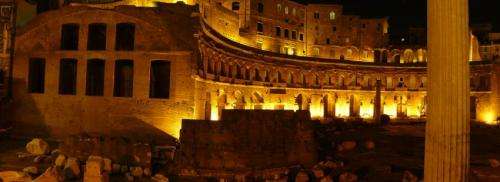April 22, 2014 report
Lead in 'tap-water' in ancient Rome up to 100 times more than local spring waters

A team of researchers with members from France, Great Britain and the U.S. has found that lead concentrations in drinking water in Rome, during the height of the Roman Empire were 100 times that of local spring waters. In their paper published in Proceedings of the National Academy of Sciences, the team describes how they took sediment samples from two sources in the city that revealed lead levels over a thousand year period.
Scientists and historians have for years debated the possibility that lead poisoning was a contributing factor in the decline and fall of the Roman Empire—water carried from afar in aqueducts was directed into lead pipes for distribution in the empire's capital city of Rome—leading to speculation that leaders had gone mad due to exposure in their drinking water. In this new effort, the researchers have concluded that while lead levels in the ancient drinking water were high, they weren't high enough to have been a major health hazard, and thus, lead cannot be blamed for the demise of the empire.
To ascertain lead levels during the time of the empire, the researchers retrieved sediment samples from two locations, the Tiber River, and the Trajanic Harbor—a man-made harbor located near the mouth of the Tiber. In analyzing the samples, the researchers were able to identify lead isotope concentrations at various depths, corresponding to different time periods. The analysis also provided clues as to the origin of the lead (other parts of Europe). They found that they were able to trace the history of the empire by noting lead levels. In the early years, lead levels were near to those of local spring water, but as time passed, levels increased dramatically as more and more lead pipes were used to transport water. Continuing forward, they found that lead levels fell along with the empire.
The authors conclude that the amount of lead in the drinking water, while a concern, was not likely to have caused brain damage. Thus it's unlikely that the poor decisions made by leaders of the time that led to fall of the empire can be blamed on lead poisoning, nor, as some have suggested, would it have led to an increase in crime throughout the city.
More information: Lead in ancient Rome's city waters, Hugo Delile, PNAS, 2014. DOI: 10.1073/pnas.1400097111
Abstract
It is now universally accepted that utilization of lead for domestic purposes and water distribution presents a major health hazard. The ancient Roman world was unaware of these risks. How far the gigantic network of lead pipes used in ancient Rome compromised public health in the city is unknown. Lead isotopes in sediments from the harbor of Imperial Rome register the presence of a strong anthropogenic component during the beginning of the Common Era and the Early Middle Ages. They demonstrate that the lead pipes of the water distribution system increased Pb contents in drinking water of the capital city by up to two orders of magnitude over the natural background. The Pb isotope record shows that the discontinuities in the pollution of the Tiber by lead are intimately entwined with the major issues affecting Late Antique Rome and its water distribution system.
Journal information: Proceedings of the National Academy of Sciences
© 2014 Phys.org



















